Spatial Modeling of Soil Erosion Risk and Its Implication for Conservation Planning: the Case of the Gobele Watershed, East Hararghe Zone, Ethiopia
Abstract
:1. Introduction
2. Materials and Methods
2.1. Description of the Study Area
2.2. Data Sources
2.3. Methods
2.3.1. Satellite Images Preprocessing
2.3.2. LULC Classification
2.3.3. Accuracy Assessment
2.3.4. Development of the RUSLE Model Factors
Rainfall Erosivity (R) Factor
Soil Erodibility (K) Factor
Slope Length and Steepness (LS) Factor
Cover Management (C) Factor
Support Practice (P) Factor
3. Results
3.1. The Soil Erosion Risk in the Gobele Watershed
3.2. Spatial Changes in Soil Erosion Risk in the Gobele Watershed
3.3. Identification of Conservation Priorities
4. Discussion
5. Conclusions
Supplementary Materials
Acknowledgments
Author Contributions
Conflicts of Interest
References
- Haan, C.T.; Barfield, B.J.; Hayes, J.C. Design Hydrology, and Sedimentology for Small Catchments; Academic Press: San Diego, CA, USA, 1994. [Google Scholar]
- Adediji, A.; Tukur, A.M.; Adepoju, K.A. Assessment of Revised Universal Soil Loss Equation (RUSLE) in Katsina Area, Katsina State of Nigeria using Remote Sensing (RS) and Geographic Information System (GIS). Iran. J. Energy Environ. 2010, 1, 255–264. [Google Scholar]
- Boardman, J. Soil Erosion in Britain: Updating the Record. Agriculture 2013, 3, 418–442. [Google Scholar] [CrossRef]
- Vrieling, A. Satellite remote sensing for water erosion assessment: A review. Catena 2006, 65, 2–18. [Google Scholar] [CrossRef]
- Abate, S. Estimating soil loss rates for soil conservation planning in the Borena Woreda of South Wollo Highlands, Ethiopia. J. Sustain. Dev. Afr. 2011, 13, 87–106. [Google Scholar]
- Kertesz, A.; Gergely, J. Gully erosion in Hungary, review and case study. Procedia-Soc. Behav. Sci. 2011, 19, 693–701. [Google Scholar] [CrossRef]
- Meshesha, D.T.; Tsunekawa, A.; Tsubo, M.; Ali, S.A.; Haregeweyn, N. Land-use change and its socio-environmental impact in Eastern Ethiopia’s highland. Reg. Environ. Chang. 2014, 14, 757–768. [Google Scholar] [CrossRef]
- Mekonnen, M.; Keesstra, S. D.; Baartman, J. E.; Stroosnijder, L.; Maroulis, J. Reducing Sediment Connectivity Through man-Made and Natural Sediment Sinks in the Minizr Catchment, Northwest Ethiopia. Land Degrad. Dev. 2017, 28, 708–717. [Google Scholar] [CrossRef]
- Knapen, A.; Kitutu, M.G.; Poesen, J.; Breugelmans, W.; Deckers, J.; Muwanga, A. Landslides in a Densely Populated County at the Foot slopes of Mount Elgon (Uganda): Characteristics and Causal Factors. Geomorphology 2006, 73, 149–165. [Google Scholar] [CrossRef]
- Sutcliff, J.P. Economic Assessment of Land Degradation in the Ethiopian Highlands: A Case Study; National Conservation Strategy Secretariat, Ministry of Planning and Economic Development: Addis Ababa, Ethiopia, 1993. [Google Scholar]
- Oldeman, L. The global extent of soil degradation. In Soil Resilience and Sustainable Land Use; Greenland, D.J., Szabolcs, I., Eds.; CAB: Wallingford, UK, 1994. [Google Scholar]
- Lal, R. Soil carbon sequestration impacts on global climate change and food security. Science 2004, 304, 1623–1627. [Google Scholar] [CrossRef] [PubMed]
- Saravanan, S.; Sathiyamurthi, S.; Elayaraja, D. Soil Erosion Mapping of Katteri Watershed using Universal Soil Loss Equation and GIS. J. Indian Soc. Soil Sci. 2010, 58, 418–421. [Google Scholar]
- Arekhi, S.; Shabani, A.; Rostamizad, G. Application of the modified universal soil loss equation (MUSLE) in prediction of sediment yield (Case study: Kengir Watershed, Iran). Arab. J. Geosci. 2012, 5, 1259–1267. [Google Scholar] [CrossRef]
- Mutowo, G.; Chikodzi, D. Erosion Hazard Mapping in the Runde Catchment: Implications for Water Resource Management. J. Geosci. Geomat. 2013, 1, 22–28. [Google Scholar] [CrossRef]
- Jiang, B.; Bamutaze, Y.; Pilesjö, P. Climate change and land degradation in Africa: A case study in the Mount Elgon region, Uganda. Geo-Spat. Inf. Sci. 2014, 17, 39–53. [Google Scholar] [CrossRef]
- Castrignano, A.; Buttafuoco, G.; Canu, A.; Madrau, S. Modelling spatial uncertainty of soil erodibility factor using joint stochastic simulation. Land Degrad. Dev. 2008, 19, 198–213. [Google Scholar] [CrossRef]
- Panagos, P.; Borrelli, P.; Meusburger, K. A New European Slope Length and Steepness Factor (LS-Factor) for Modeling Soil Erosion by Water. Geosciences 2015, 5, 117–126. [Google Scholar] [CrossRef] [Green Version]
- Bhattacharyya, R.; Ghosh, B.N.; Dogra, P.; Mishra, P.K.; Santra, P.; Kumar, S.; Fullen, M.A.; Mandal, U.K.; Anil, K.S.; Lalitha, M.; et al. Soil Conservation Issues in India. Sustainability 2016, 8, 565. [Google Scholar] [CrossRef] [Green Version]
- Lal, R. Agronomic consequences of soil erosion. In Soil Erosion at Multiple Scales: Principles and Methods for Assessing Causes and Effects; Vries, F.W.T., Agus, F., Kerr, J., Eds.; CABI Publishing: New York, NY, USA, 1998. [Google Scholar]
- Fazlı, E.T.; Mahmut, Y.; Murat, S.; İbrahim, M.; Mustafa, C. Assessment of Soil Erosion Based on The Method USLE; Çorum Province Example. In Proceedings of the FIG Working Week—knowing to manage the territory, protect the environment, evaluate the cultural heritage, Rome, Italy, 6–10 May 2012. [Google Scholar]
- Rabia, A.H. Mapping Soil Erosion Risk Using RUSLE, GIS and Remote Sensing. In Proceedings of the 4th International Congress of ECSSS, EUROSOIL, Soil Science for the Benefit of Mankind and Environment, Bari, Italy, 2–6 June 2012; p. 1082. [Google Scholar]
- Nill, D.; Schwertmann, U.; Sabel-Koschella, U.; Bernhard, M.; Breuer, J. Soil Erosion by Water in Africa: Principle, Prediction and Protection; GTZ: Eschborn, Germany, 1996; p. 292. [Google Scholar]
- Ermias, A.; Welday, W.; Emiru, B.; Nigussu, B. Monitoring and Evaluating Land use/Land cover change using participatory Geographic Information System Tools: A case study of Begasheka watershed, Tigray, Ethiopia. EJISDC 2006, 25, 1–10. [Google Scholar]
- Hudad, B. Multi-temporal Satellite Image Analysis for Assessing Land Degradation; A Case Study on South Wollo Zone, Doyach Watershed. Master’s Thesis, Addis Ababa University, Addis Ababa, Ethiopia, 2010. [Google Scholar]
- Kassu, K. Soil Erosion, Deforestation and Rural Livelihoods in the Central Rift Valley Area of Ethiopia: A Case Study in the Denku Micro-Watershed Oromia Region. Master’s Thesis, University of South Africa, Pretoria, South Africa, 2011. [Google Scholar]
- Amsalu, T.; Mengaw, A. GIS Based Soil Loss Estimation Using RUSLE Model: The Case of Jabi Tehinan Woreda, ANRS, Ethiopia. Nat. Resour. 2014, 5, 616–626. [Google Scholar] [CrossRef]
- Araya, A.; Stroosnijder, L.; Habtu, S.; Keesstra, S.D.; Berhe, M.; Hadgu, K.M. Risk assessment by sowing date for barley (Hordeum vulgare) in northern Ethiopia. Agric. For. Meteorol. 2012, 154, 30–37. [Google Scholar] [CrossRef]
- Muluneh, A.; Biazin, B.; Stroosnijder, L.; Bewket, W.; Keesstra, S. Impact of predicted changes in rainfall and atmospheric carbon dioxide on maize and wheat yields in the Central Rift Valley of Ethiopia. Reg. Environ. Chang. 2015, 15, 1105–1119. [Google Scholar] [CrossRef]
- Muluneh, A.; Bewket, W.; Keesstra, S.; Stroosnijder, L. Searching for evidence of changes in extreme rainfall indices in the Central Rift Valley of Ethiopia. Theor. Appl. Clim. 2017, 128, 795–809. [Google Scholar] [CrossRef]
- Muluneh, A.; Stroosnijder, L.; Keesstra, S.; Biazin, B. Adapting to climate change for food security in the Rift Valley dry lands of Ethiopia: supplemental irrigation, plant density and sowing date. J. Agric. Sci. 2017, 155, 703–724. [Google Scholar] [CrossRef]
- Erenstein. Sustainable Poverty Reduction in Less Favored Area; Cromwell Press: Trowbridge, UK, 1999. [Google Scholar]
- Ayalew, G. Geographic information system based soil loss estimation in Zingin Watershed for soil conservation planning, highlands of Ethiopia. Int. J. Sci. Technol. Soc. 2015, 3, 28–35. [Google Scholar] [CrossRef]
- Lal, R. Soil degradation by erosion. Land Degrad. Dev. 2001, 12, 519–539. [Google Scholar] [CrossRef]
- The Federal Democratic Republic of Ethiopia (FDRE). Ethiopia’s Climate-Resilient Green Economy, Green Economy Strategy; Environmental Protection Authority: Addis Ababa, Ethiopia, 2011.
- Community-Based Participatory Watershed Management (CBPWM). Integrated Watershed Management in Rainfed Agriculture; CRC Press: Leiden, The Netherlands, 2005. [Google Scholar]
- Tamene, L.; Vlek, P.L.G. GIS-based landscape characterization to assess soil erosion and its delivery potential in the highlands of northern Ethiopia. In Proceedings of the 1st International Conference on Remote Sensing and Geoinformation Processing in the Assessment and Monitoring of Land Degradation and Desertification, Trier, Germany, 7–9 September 2005; pp. 332–339. [Google Scholar]
- Food and Agriculture Organization (FAO). Ethiopian Highland Reclamation Study; Final Report; FAO: Rome, Italy, 1986; pp. 37–46. [Google Scholar]
- Tamene, L.; Vlek, P.L.G. Analysis of factors determining sediment yield variability in the highlands of Northern Ethiopia. Geomorphology 2006, 76, 76–91. [Google Scholar] [CrossRef]
- Food and Agriculture Organization (FAO). Ethiopian Highland Reclamation Study (EHRS); Final Report; FAO: Rome, Italy, 1984. [Google Scholar]
- Gebreyesus, B.; Lulseged, T.; Paul, L.G. Soil Erosion Prediction Using Morgan-Morgan-Finney Model in a GIS Environment in Northern Ethiopia Catchment. Appl. Environ. Soil Sci. 2014, 2014, 468751. [Google Scholar]
- The Federal Democratic Republic of Ethiopia (FDRE). Rural Development Policy and Strategies; Ministry of Finance and Economic Development Economic Policy and Planning Department: Addis Ababa, Ethiopia, 2003.
- The Federal Democratic Republic of Ethiopia (FDRE). Growth and Transformation Plan (GTP); Ministry of Finance and Economic Development (MoFED): Addis Ababa, Ethiopia, 2010.
- Tripathi, M.P.; Panda, R.K.; Raghuwanshi, N.S. Identification and prioritization of critical sub-watersheds for soil conservation management using the SWAT model. Biosyst. Eng. 2003, 85, 365–379. [Google Scholar] [CrossRef]
- Hurni, H. Degradation and Conservation of the Resources in the Ethiopian highlands. Mt. Res. Dev. 1988, 8, 123–130. [Google Scholar] [CrossRef]
- Barakat, M.; Mahfoud, I.; Kwyes, A.A. Study of soil erosion risk in the Basin of Northern Al-Kabeer River at Lattakia-Syria using remote sensing and GIS techniques. Mesopot. J. Mar. Sci. 2014, 29, 29–44. [Google Scholar]
- Ganasri, B.P.; Ramesh, H. Assessment of soil erosion by RUSLE model using remote sensing and GIS, a case study of Nethravathi Basin. Geosci. Front. 2016, 7, 953–961. [Google Scholar] [CrossRef]
- Claessens, L.; Breugel, P.V.; Notenbaert, A.; Herrero, M.; De Steeg, J.V. Mapping potential soil erosion in East Africa using the Universal Soil Loss Equation and secondary data California, USA. In Sediment Dynamics in Changing Environments, Proceedings of a Symposium Held in Christchurch, New Zealand, 1–5 December 2008; IAHS Publication: Wallingford, UK, 2008; p. 588. [Google Scholar]
- Tekwa, I.J.; Kundiri, A.M.; Chiroma, A.M. Efficiency test of modeled empirical equations in predicting soil loss from ephemeral gully erosion around Mubi, Northeast Nigeria. Int. Soil Water Conserv. Res. 2016, 4, 12–19. [Google Scholar] [CrossRef]
- Cerdàa, A.; Rodrigo-Comino, J.; Giménez-Morera, A.; Keesstra, S.D. An economic, perception and biophysical approach to the use of oat straw as mulch in Mediterranean rainfed agriculture land. Ecol. Eng. 2017, 108, 162–171. [Google Scholar] [CrossRef]
- Keesstra, S.; Nunes, J.; Novara, A.; Finger, D.; Avelar, D.; Kalantari, Z.; Cerdà, A. The superior effect of nature based solutions in land management for enhancing ecosystem services. Sci. Total Environ. 2018, 610, 997–1009. [Google Scholar] [CrossRef] [PubMed]
- Kirchhoff, M.; Rodrigo-Comino, J.; Seeger, M.; Ries, J. B. Soil erosion in sloping vineyards under conventional and organic land use managements (Saar-Mosel valley, Germany). Cuadernos de Investigación Geográfica 2017, 43, 119–140. [Google Scholar] [CrossRef]
- Williams, J.R. Sediment routing for Agricultural Watersheds. Water Resour. Bull. 1975, 11, 965–974. [Google Scholar] [CrossRef]
- Wischmeier, W.H.; Smith, D.D. Predicting Rainfall Erosion Losses—A Guide to Conservation Planning; Agriculture Handbook No. 537; US Department of Agriculture Science and Education Administration: Washington, DC, USA, 1978; p. 168.
- Morgan, R.P.C.; Morgan, D.D.V.; Finney, H.J. A predictive model for the assessment of soil erosion risk. J. Agric. Eng. Res. 1984, 30, 245–253. [Google Scholar] [CrossRef]
- Young, R.A.; Onstad, C.; Bosch, D.; Anderson, W. AGNPS: A nonpoint-source pollution model for evaluating agricultural watersheds. J. Soil Water Conserv. 1989, 44, 168–173. [Google Scholar]
- Sharpley, A.N.; Williams, J.R. EPIC Erosion/Productivity Impact Calculator: 1. Model Documentation; USA Department of Agriculture Technical Bulletin No. 1768; USA Government Printing Office: Washington, DC, USA, 1990.
- Flangan, D.C.; Nearing, M.A. USDA Water Erosion Prediction Project: Hill Slope Profile and Watershed Model Documentation; NSERL Report No. 10; USDA-ARS National Soil Erosion Research Laboratory: West Lafayette, IN, USA, 1995; Volume 47, pp. 907–1194.
- Arnold, J.G.; Srinivasan, R.; Muttiah, R.S.; Williams, J.R. Large area hydrologic modeling, and assessment part I: Model Development. J. Am. Water Resour. Assoc. 1998, 34, 73–89. [Google Scholar] [CrossRef]
- Morgan, R.P.C.; Quinton, J.N.; Smith, R.E.; Govers, G.; Poesen, J.W.A.; Auerswald, K.; Chisci, G.; Torri, D.; Styczen, M.E. The European Soil Erosion Model (EUROSEM): A dynamic approach for predicting sediment transport from fields and small catchments. Earth Surf. Process. Landf. 1998, 23, 527–544. [Google Scholar] [CrossRef]
- Chang, T.J.; Zhou, H.; Guan, Y. Applications of Erosion Hotspots for Watershed Investigation in the Appalachian Hills of the United States. J. Irrig. Drain Eng. 2016, 142. [Google Scholar] [CrossRef]
- Laflen, J.M.; Flanagan, D.C.; Engel, B.A. Soil erosion and Sediment Yield Prediction Accuracy Using WEPP. J. Am. Water Resour. Assoc. 2004, 289–297. [Google Scholar] [CrossRef]
- Renard, K.G.; Foster, G.R.; Weesies, G.A.; McCool, D.K.; Yoder, D.C. Predicting Soil Erosion by Water: A Guide to Conservation Planning with the Revised Universal Soil Loss Equation (RUSLE); Agriculture Handbook; USDA: Washington, DC, USA, 1997; Volume 703, pp. 1–251.
- Mellerowicz, K.; Ress, H.; Chow, T.; Ghanem, I. Soil conservation planning at the watershed level using the Universal Soil Loss Equation with GIS and microcomputer technologies: A case study. J. Soil Water Conserv. 1994, 49, 194–200. [Google Scholar]
- Millward, A.A.; Mersey, J.E. Adapting the RUSLE to model soil erosion potential in a mountainous tropical watershed. Catena 1999, 38, 109–129. [Google Scholar] [CrossRef]
- Ratnam, K.; Srivastava, Y.; Rao, V.; Amminedu, E.; Murthy, K. Check Dam Positioning by Prioritization Micro-Watersheds Using SYI Model and Morphometric Analysis-Remote Sensing and GIS Perspective. J. Indian Soc. Remote Sens. 2005, 33. [Google Scholar] [CrossRef]
- Li, X.S.; Wu, B.F.; Wang, H.; Zhang, J. Regional soil erosion risk assessment in Hai Basin. J. Remote Sens. 2011, 15, 372–387. [Google Scholar]
- Kiflu, G. GIS-Based Conservation Priority Area Identification in Mojo River Watershed on the Basis of Erosion Risk. Master’s Thesis, Addis Ababa University, Addis Ababa, Ethiopia, 2010. [Google Scholar]
- Ayele, K. Assessment of Soil Erosion Risk in the Holeta Watershed, Central Oromiya, Ethiopia. Master’s Thesis, Addis Ababa University, Addis Ababa, Ethiopia, 2011. [Google Scholar]
- Israel, T. Soil Erosion Risk Assessment with RUSLE and GIS in Dire Dam Watershed. Master’s Thesis, Addis Ababa University, Addis Ababa, Ethiopia, 2011. [Google Scholar]
- Senti, E.T.; Tufa, B.W.; Gebrehiwot, K.A. Soil erosion, sediment yield and conservation practices assessment on Lake Haramaya Catchment. World J. Agric. Sci. 2014, 2, 186–193. [Google Scholar]
- National Meteorological Agency (NMA). Mean Monthly Rainfall Data; Unpublished document; 2015. [Google Scholar]
- Earth Explorer. Available online: http://earthexplorer.usgs.gov/ (accessed on 15 September 2016).
- National Aeronautics and Space Administration (NASA); Land Processes Distributed Active Archive Center (LPDAAC). ASTER L1B; The United States Geological Survey (USGS)/Earth Resources Observation and Science (EROS) Center: Sioux Falls, SD, USA, 2016. Available online: http://www.gdem.aster.ersdac.or.jp/ (accessed on 15 September 2016).
- Food and Agriculture Organization (FAO). The Digital Soil Map of the World, Land and Water Development Division; FAO: Rome, Italy, 1995; Available online: http://www.fao.org/geonetwork/ (accessed on 7 August 2016).
- Lillesand, T.; Kiefer, R. Remote Sensing and Image Interpretation; John Wiley & Sons, Inc.: New York, NY, USA, 1999. [Google Scholar]
- Mather, P.; Koch, M. Computer Processing of Remotely-Sensed Images: An Introduction, 4th ed.; Wiley-Blackwell: Chichester, UK, 2011. [Google Scholar]
- Song, C.; Woodcock, C.E.; Seto, K.C.; Lenney, M.P.; Macomber, S.A. Classification and change detection using Landsat TM data: When and how to correct atmospheric effects? Remote Sens. Environ. 2001, 75, 230–244. [Google Scholar] [CrossRef]
- Papadavid, G.; Hadjimitsis, D.; Toulios, L.; Michaelides, L. Mapping Potatoes Crop Height and LAI through Vegetation Indices using Remote Sensing, in Cyprus. J. Appl. Remote Sens. 2011, 5. [Google Scholar] [CrossRef]
- Cheruto, M.C.; Kauti, M.K.; Kisangau, P.D.; Kariuki, P. Assessment of Land Use and Land Cover Change Using GIS and Remote Sensing Techniques: A Case Study of Makueni County, Kenya. J. Remote Sens. GIS 2016, 5, 175. [Google Scholar] [CrossRef]
- Raja, D.R. Spatial Analysis of Land Surface Temperature in Dhaka Metropolitan Area. J. Bangladesh Inst. Plan. 2012, 5, 151–167. [Google Scholar]
- Lillesand, T.; Kiefer, R. Remote Sensing and Photo Interpretation, 3rd ed.; Wiley: New York, NY, USA, 1994; p. 750. [Google Scholar]
- Otukei, J.R.; Blaschke, T. Land cover change assessment using decision trees, support vector machines and maximum likelihood classification algorithms. Int. J. Appl. Earth Observ. Geoinform. 2010, 12, 27–31. [Google Scholar] [CrossRef]
- Sahana, M.; Ahmed, R.; Sajjad, H. Analyzing land surface temperature distribution in response to land use/land cover change using split window algorithm and spectral radiance model in Sundarbans Biosphere Reserve, India. Model. Earth Syst. Environ. 2016, 2, 1–11. [Google Scholar] [CrossRef]
- Congalton, R. A review of assessing the accuracy of classifications of remotely sensed data. Remote Sens. Environ. 1991, 37, 35–46. [Google Scholar] [CrossRef]
- Hickey, R.A.; Smith, L.C.; Jankowski, P. Slope length calculations from a DEM within ARC/INFO GRID. Comput. Environ. Urban Syst. 1994, 18, 365–380. [Google Scholar] [CrossRef]
- Karamage, F.; Zhang, C.; Ndayisaba, F.; Shao, H.; Kayiranga, A.; Fang, X.; Nahayo, L.; Nyesheja, E.M.; Tian, G. Extent of Cropland and Related Soil Erosion Risk in Rwanda. Sustainability 2016, 8, 609. [Google Scholar] [CrossRef]
- Burrough, P.A.; McDonnell, R.A. Principles of Geographical Information Systems, 2nd ed.; Oxford University Press: London, UK, 1998. [Google Scholar]
- Ai, L.; Fang, N.F.; Zhang, B.; Shi, Z.H. Broad area mapping of monthly soil erosion risk using fuzzy decision tree approach: Integration of multi-source data within GIS. Int. J. Geogr. Inf. Sci. 2013, 27, 1251–1267. [Google Scholar] [CrossRef]
- Uddin, K.; Murthy, M.S.R.; Wahid, S.M.; Matin, M.A. Estimation of Soil Erosion Dynamics in the Koshi Basin Using GIS and Remote Sensing to Assess Priority Areas for Conservation. PLoS ONE 2016, 11, e0150494. [Google Scholar] [CrossRef] [PubMed]
- Zhang, X.; Wu, B.; Ling, F.; Zeng, Y.; Yan, N.; Yuan, C. Identification of priority areas for controlling soil erosion. Catena 2010, 83, 76–86. [Google Scholar] [CrossRef]
- Wang, L.; Huang, J.; Du, Y.; Hu, Y.; Han, P. Dynamic Assessment of Soil Erosion Risk Using Landsat TM and HJ Satellite Data in Danjiangkou Reservoir Area, China. Remote Sens. 2013, 5, 3826–3848. [Google Scholar] [CrossRef]
- Owusu, J. A GIS-Based Estimation of Soil Loss in the Densu Basin in Ghana. West Afr. J. Appl. Ecol. 2012, 20, 42–52. [Google Scholar]
- Land Degradation Assessment in Drylands. Global Land Degradation Information System-Beta Version. Available online: http://www.fao.org/nr/lada/index.php?option=com_content&view=article&id=161& Itemid=113&lang=en (accessed on 15 June 2017).
- Lo, A.; El-Swaify, S.; Dangler, E.; Shinshiro, L. Effectiveness of EI 30 as an Erosivity Index in Hawaii. Available online: http://agris.fao.org/agris-search/search.do?recordID=US8639059 (accessed on 15 June 2017).
- Parysow, P.; Wang, G.X.; Gartner, G.; Anderson, A.B. Spatial uncertainty analysis for mapping soil erodibility based on joint sequential simulation. Catena 2003, 53, 65–78. [Google Scholar] [CrossRef]
- Lal, R. Soil Erosion Research Method, 2nd ed.; Soil and Water Conservation Society: Ankeny, IA, USA, 1994. [Google Scholar]
- Hoyos, N. Spatial Modeling of Soil Erosion Potential in a Tropical Watershed of the Colombian Andes. Catena 2005, 63, 85–108. [Google Scholar] [CrossRef]
- Yang, S.; Lianyou, L.; Ping, Y.; Tong, C. A review of soil erodibility in water and wind erosion research. J. Geogr. Sci. 2005, 15, 167–176. [Google Scholar]
- Rao, C.V.; Ashenafi, T.; Aminnedu, E. Erosion risk identification study using RUSLE model in G. Madugula Mandal, Visakhapatnam District, A.P., India. Eur. Acad. Res. 2014, 2, 12246–12260. [Google Scholar]
- Zakerinejad, R.; Maerker, M. An integrated assessment of soil erosion dynamics with special emphasis on gully erosion in the Mazayjan basin, southwestern Iran. Nat. Hazards 2015, 79, 25–50. [Google Scholar] [CrossRef]
- Hudson, N. Soil Conservation; Batsford Academic and Educational: London, UK, 1981. [Google Scholar]
- Yahya, F.; Zregat, D.; Farhan, I. Spatial Estimation of Soil Erosion Risk Using RUSLE Approach, RS, and GIS Techniques: A Case Study of Kufranja Watershed, Northern Jordan. J. Water Resour. Prot. 2013, 5, 1247–1261. [Google Scholar]
- United States Department of Agriculture. EPIC-Erosion/productivity Impact Calculator 1. Model Documentation; Technical Bulletin Number 1768; United States Department of Agriculture: Washington, DC, USA, 1990. [Google Scholar]
- Neitsch, S.L.; Arnold, J.G.; Kiniry, J.R.; Williams, J.R. Erosion Soil and Water Assessment Tool: Theoretical Documentatio; Blackland Research Center, Texas Agricultural Experiment Station: Temple, TX, USA, 2005; p. 494. [Google Scholar]
- Wawer, R.; Nowocien, E.; Podolski, B. Real and Calculated KUSLE Erodibility Factor for Selected Polish Soils. Pol. J. Environ. Stud. 2005, 14, 655–658. [Google Scholar]
- Anache, J.A.A.; Bacchi, C.G.V.; Panachuki, E.; Sobrinho, T.A. Assessment of Methods for Predicting Soil erodibility in Soil Loss Modeling. São Paulo, UNESP. Geociências 2015, 34, 32–40. [Google Scholar]
- Nigel, R.; Rughooputh, S.D. Soil erosion risk mapping with new datasets: An improved identification and prioritization of high erosion risk areas. Catena 2010, 82, 191–205. [Google Scholar] [CrossRef]
- McCool, D.K.; Foster, G.R.; Mutchler, C.K.; Meyer, L.D. Revised slope length factor for the Universal Soil Loss Equation. Trans. Am. Soc. Agric. Eng. 1989, 32, 1571–1576. [Google Scholar] [CrossRef]
- Foster, G.R.; Wischmeier, W. Evaluating Irregular Slopes for Soil loss prediction. Trans. Am. Soc. Agric. Eng. 1974, 17, 305–309. [Google Scholar] [CrossRef]
- Desmet, P.; Govers, G. A GIS procedure for automatically calculating the USLE LS factor on topographically complex landscape units. J. Soil Water Conserv. 1996, 51, 427–433. [Google Scholar]
- McCool, D.K.; Brown, L.C.; Foster, G.R.; Mutchler, C.K.; Meyer, L.D. Revised slope steepness factor for the Universal Soil Loss Equation. Trans. Am. Soc. Agric. Eng. 1987, 30, 1387–1396. [Google Scholar] [CrossRef]
- Tucker, C.J. Red and photographic infrared linear combinations for monitoring vegetation. Remote Sens. Environ. 1979, 8, 127–150. [Google Scholar] [CrossRef]
- Ahmed, B.; Kamruzzaman, Md.; Zhu, X.; Rahman, S.; Choi, K. Simulating Land Cover Changes and Their Impacts on Land Surface Temperature in Dhaka, Bangladesh. Remote Sens. 2013, 5, 5969–5998. [Google Scholar] [CrossRef] [Green Version]
- Fathizad, H.; Karimi, H.; Alibakhshi, S.M. The estimation of erosion and sediment by using the RUSLE model and RS and GIS techniques (Case study: Arid and semi-arid regions of Doviraj, Ilam province, Iran). Int. J. Agric. Crop Sci. 2014, 7, 304–314. [Google Scholar]
- Tirkey, A.; Pandey, A.C.; Nathawat, M.S. Use of Satellite Data, GIS and RUSLE for Estimation of Average Annual Soil Loss in Daltonganj Watershed of Jharkhand (India). J. Remote Sens. Technol. 2013. [Google Scholar] [CrossRef]
- Kim, H.S. Soil Erosion Modeling Using RUSLE and GIS on the IMHA Watershed, South Korea. Master’s Thesis, Colorado State University, Fort Collins, CO, USA, 2006. [Google Scholar]
- Ayalew, G.; Selassie, Y.G. Soil Loss Estimation for Soil Conservation Planning using Geographic Information System in Guang Watershed, Blue Nile Basin. J. Environ. Earth Sci. 2015, 5, 126–134. [Google Scholar]
- Troeh, F.R.; Hobbs, A.J.; Donahue, R.L. Soil and Water Conservation, 2nd ed.; Prentice-Hall Incorporation: Needham, MA, USA, 1991; pp. 81–86. [Google Scholar]
- Kelbesa, W.K. Ethiopian Environmental Policy: Challenges and Prospects on Sustainable Social and Economic Development. Master’s Thesis, Indira Gandhi National Open University, New Delhi, India, 2012. [Google Scholar]
- Cesare, E.; Ekbom, A. Ethiopia Environmental and Climate Change Policy Brief; Sida’s Helpdesk for Environment and Climate Change: Addis Abeba, Ethiopia, 2013. [Google Scholar]
- Yesuf, M.; Mekonnen, M.; Kassie, M.; Pender, J. Cost of Land Degradation in Ethiopia: A critical Review of Past Studies; Environment for Development, World Bank: Washington, DC, USA, 2007. [Google Scholar]
- Bewket, W.; Teferi, E. Assessment of soil erosion hazard and prioritization for treatment at the watershed level: A case study in the Chemoga watershed, Blue Nile Basin, Ethiopia. Land Degrad. Dev. 2009. [Google Scholar] [CrossRef]
- Gelagay, H.S.; Minale, A.S. Soil loss estimation using GIS and Remote sensing techniques: A case of Koga watershed, Northwestern Ethiopia. Int. Soil Water Conserv. Res. 2016, 4, 126–136. [Google Scholar] [CrossRef]
- Hurni, H. Erosion Productivity Conservation Systems in Ethiopia. In Proceedings of the 4th International Conference on Soil Conservation, Maracay, Venezuela, 3–9 November 1985. [Google Scholar]
- Gebreyesus, B.; Kirubel, M. Estimating Soil Loss Using Universal Soil Loss Equation (USLE) for Soil Conservation planning at Medego Watershed, Northern Ethiopia. J. Am. Sci. 2009, 5, 58–69. [Google Scholar]
- Hana, M.A. Assessment of Soil Erosion Risk with RUSLE and GIS in Geffersa Watershed, West Shewa Zone Oromiya Region. Master’s Thesis, Addis Ababa University, Addis Ababa, Ethiopia, 2014. [Google Scholar]
- Lahlaoi, H.; Rhinane, H.; Hilali, A.; Lahssini, S.; Khalile, L. Potential Erosion Risk Calculation Using Remote Sensing and GIS in Oued El Maleh Watershed, Morocco. J. Geogr. Inf. Syst. 2015, 7, 128–139. [Google Scholar] [CrossRef]
- Cebecauer, T.; Hofierka, J. The consequences of land-cover changes on soil erosion distribution in Slovakia. Geomorphology 2008, 98, 187–198. [Google Scholar] [CrossRef]
- Gete, Z. Landscape Dynamics and Soil Erosion Process Modeling in the Northwestern Ethiopia Highlands; African Studies Series; University of Berne: Berne, Switzerland, 2000. [Google Scholar]
- Efe, R.; Ekinci, D.; Cürebal, I. Erosion Analysis of Fındıkli Creek catchment (Northwest of Turkey) using GIS based on RUSLE (3D) Method. Fresenius Environ. Bull. 2008, 17, 576–586. [Google Scholar]
- De Carvalho, D.F.; Durigon, V.L.; Antunes, M.A.H.; Almeida, W.S.; Oliveira, P.T.S. Predicting Soil Erosion Using RUSLE and NDVI Time series From TM Landsat 5. Pesq. Agropec. Bras. 2014, 49, 215–224. [Google Scholar] [CrossRef]
- Karamage, F.; Zhang, C.; Kayiranga, A.; Shao, H.; Fang, X.; Ndayisaba, F.; Nahayo, L.; Mupenzi, C.; Tian, G. USLE-Based Assessment of Soil Erosion by Water in the Nyabarongo River Catchment, Rwanda. Int. J. Environ. Res. Public Health 2016, 13, 835. [Google Scholar] [CrossRef] [PubMed]
- Daba, S. An investigation of the physical and socioeconomic determinants of soil erosion in the Hararghe highlands, eastern Ethiopia. Land Degrad. Dev. 2003, 14, 69–81. [Google Scholar] [CrossRef]
- Samuel, L.M. Prediction of Runoff and Sediment Yield Using AnnAGNPS Model: Case of Erer-Guda Catchment, East Hararghe, Ethiopia. ARPN J. Sci. Technol. 2014, 4, 575–595. [Google Scholar]
- Alemayehu, T.; Furi, W.; Legesse, D. Impact of water overexploitation on highland lakes of eastern Ethiopia. Environ. Geol. 2007, 52, 147–154. [Google Scholar] [CrossRef]
- Setegn, S.G.; Yohannes, F.; Quraishi, S.; Chowdary, V.M.; Mal, B.C. Impact of Land Use/Land Cover Transformations on Alemaya Lake, Ethiopia. J. Indian Water Resour. Soc. 2009, 29, 40–45. [Google Scholar]
- Assen, M. Land use/cover dynamics and its implications in the dried Lake Alemaya watershed, Eastern Ethiopia. J. Sustain. Dev. Afr. 2011, 13, 267–284. [Google Scholar]
- Tadesse, L.; Suryabhagavan, K.V.; Sridhar, G.; Legesse, G. Land use and land cover changes and Soil erosion in Yezat Watershed, North Western Ethiopia. Int. Soil Water Conserv. Res. 2017, 5, 85–94. [Google Scholar] [CrossRef]
- Akale, T.A.; Dagnew, D.C.; Belete, M.A.; Tilahun, S.A. Mekuria, W.; Steenhuis, T.S. Impact of Soil Depth and Topography on the Effectiveness of Conservation Practices on Discharge and Soil Loss in the Ethiopian Highlands. Land 2017, 6, 78. [Google Scholar] [CrossRef]
- Lemessa, D. Khat (Catha edulis): Botany, Distribution, Cultivation, Usage and Economics in Ethiopia; UN-Emergencies Unit for Ethiopia: Addis Ababa, Ethiopia, 2001. [Google Scholar]
- Adugna, A.; Abegaz, A.; Cerdà, A. Soil erosion assessment and control in Northeast Wollega, Ethiopia. Solid Earth Discuss. 2015, 7, 3511–3540. [Google Scholar] [CrossRef]
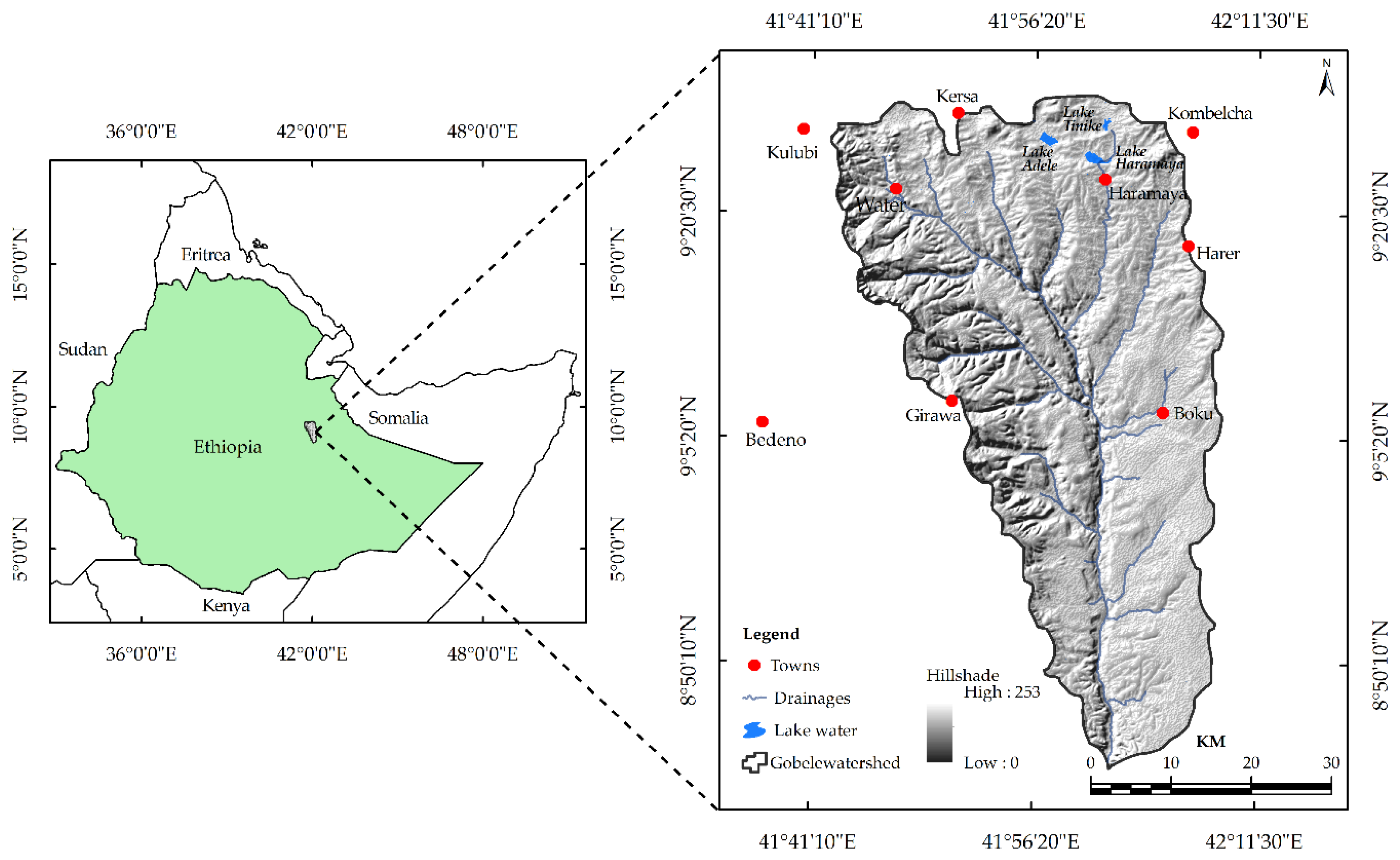

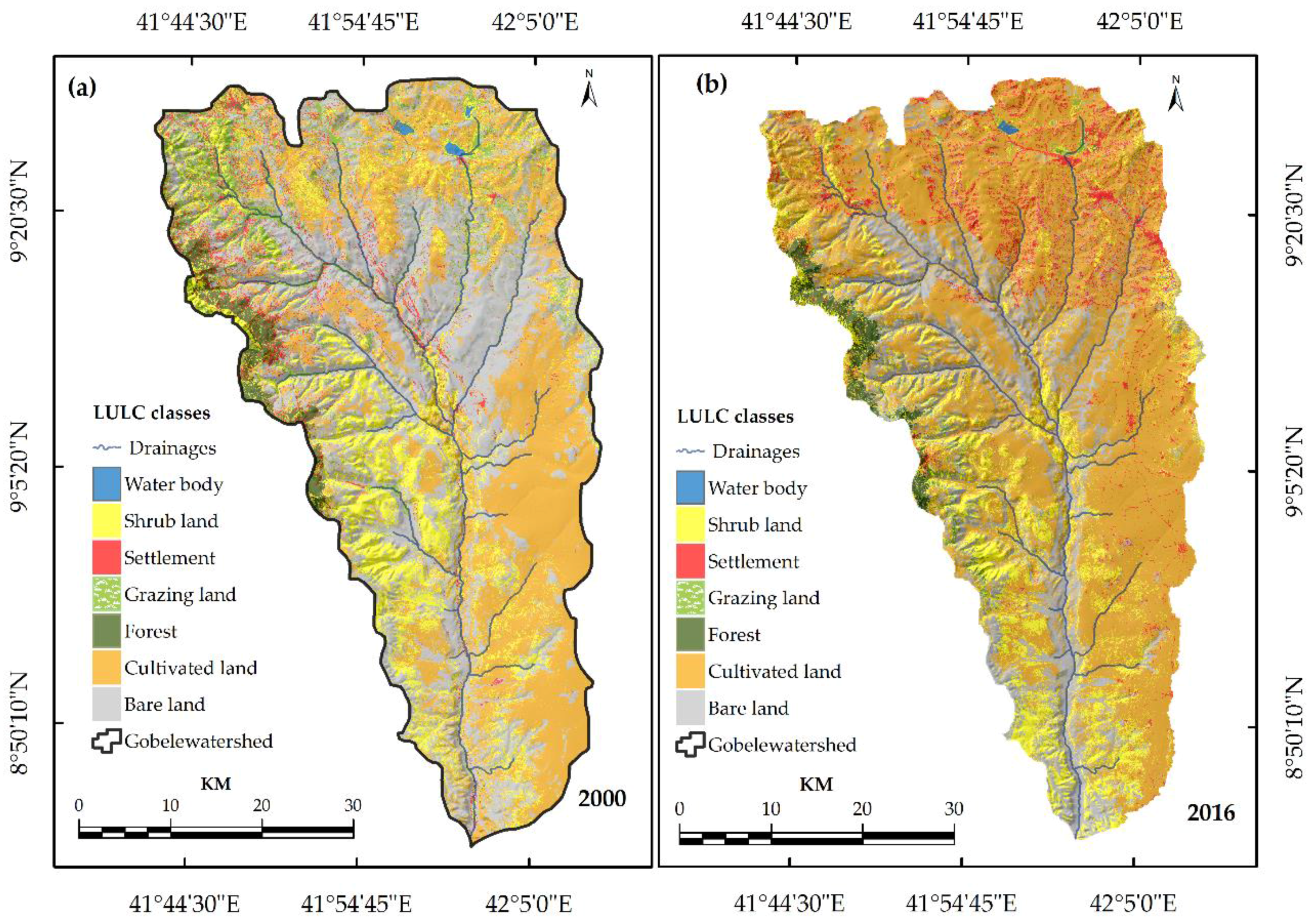
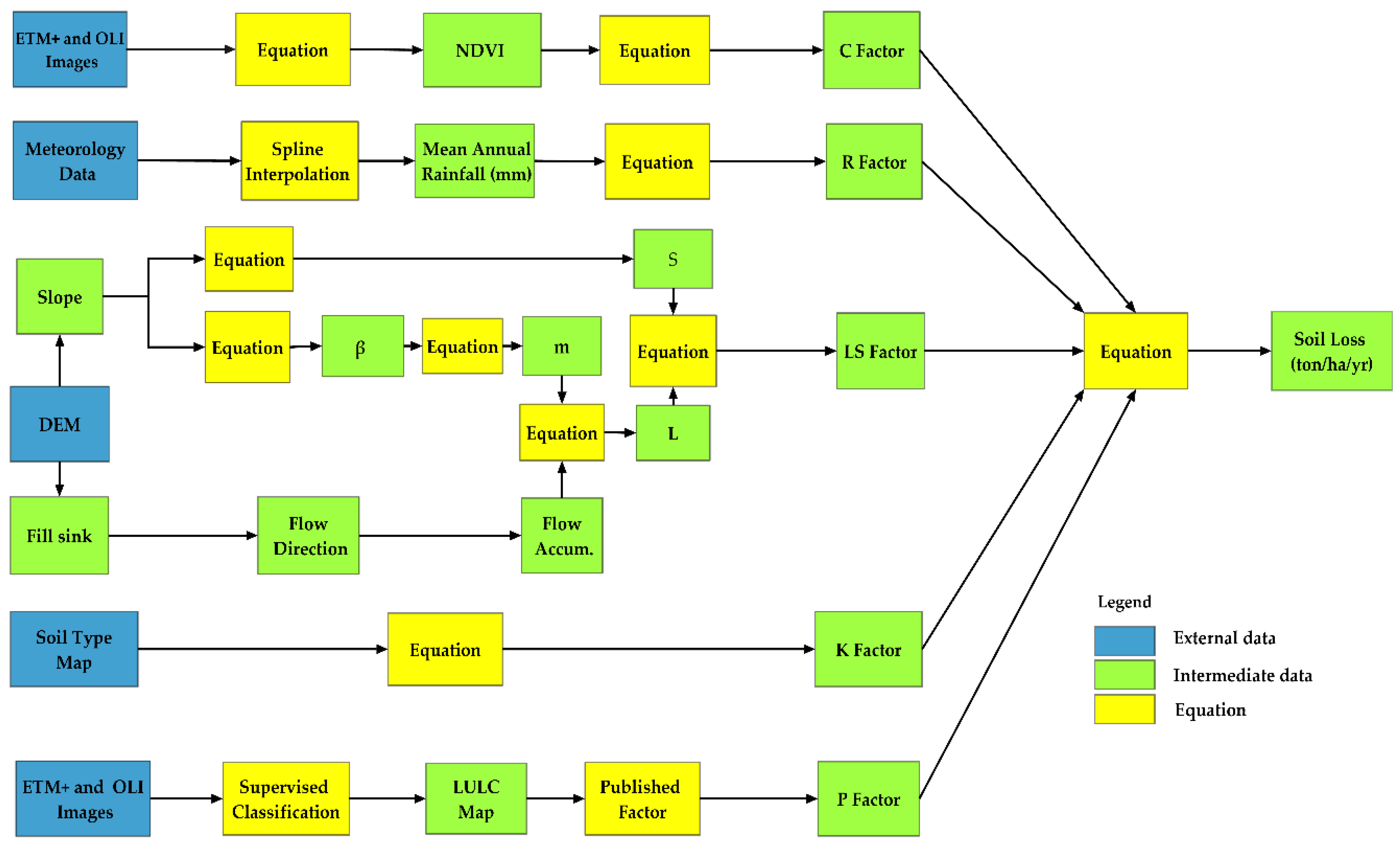
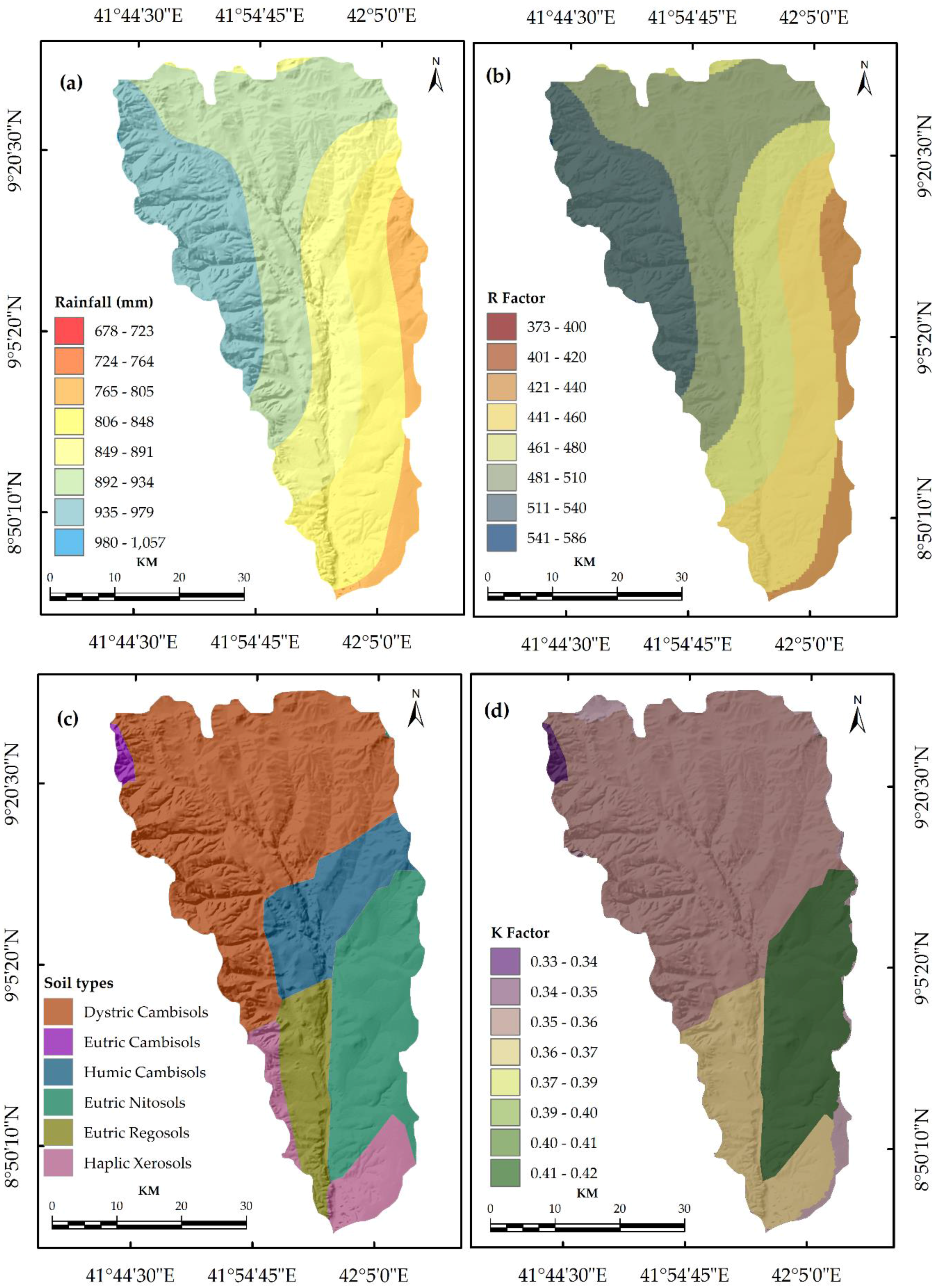
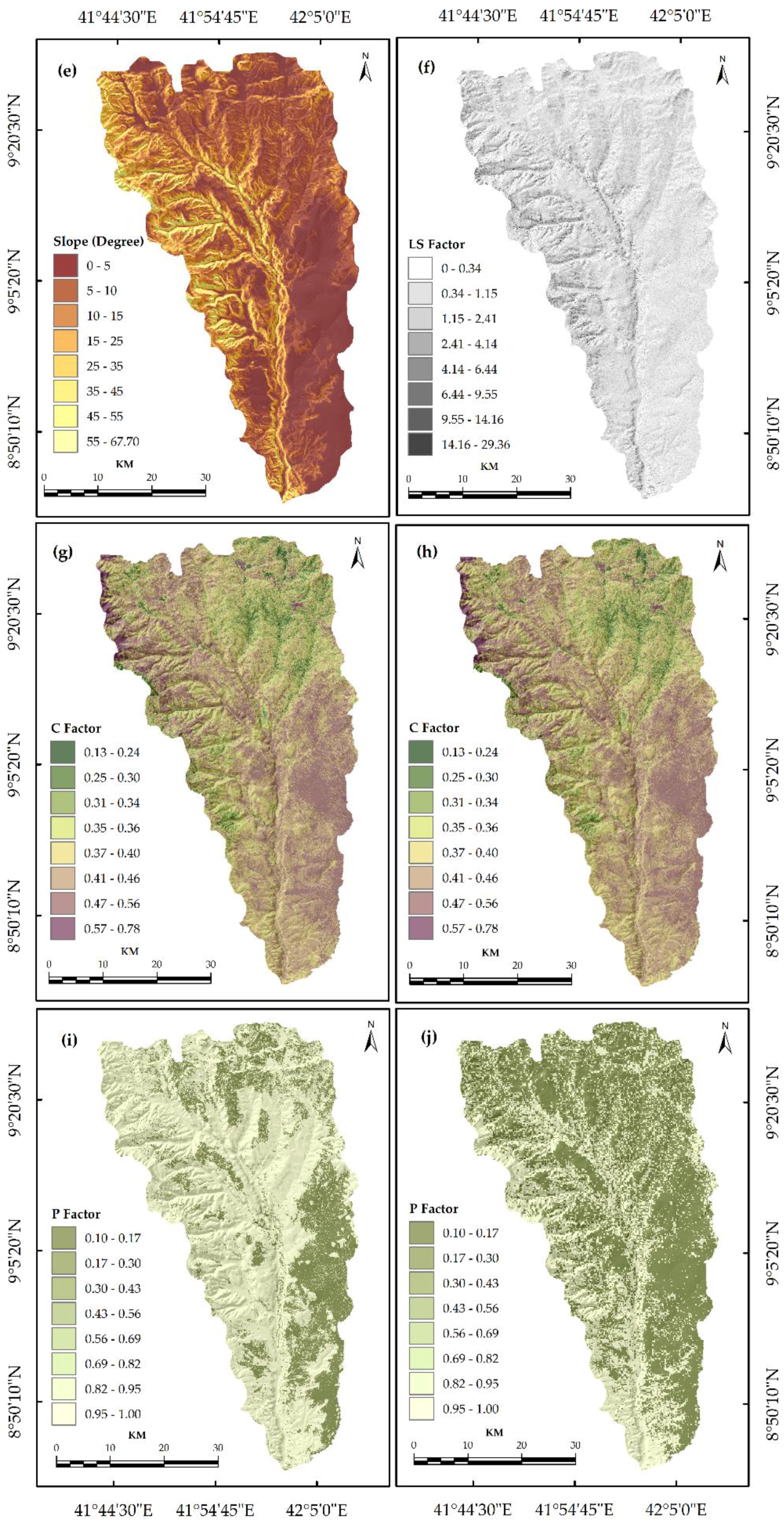
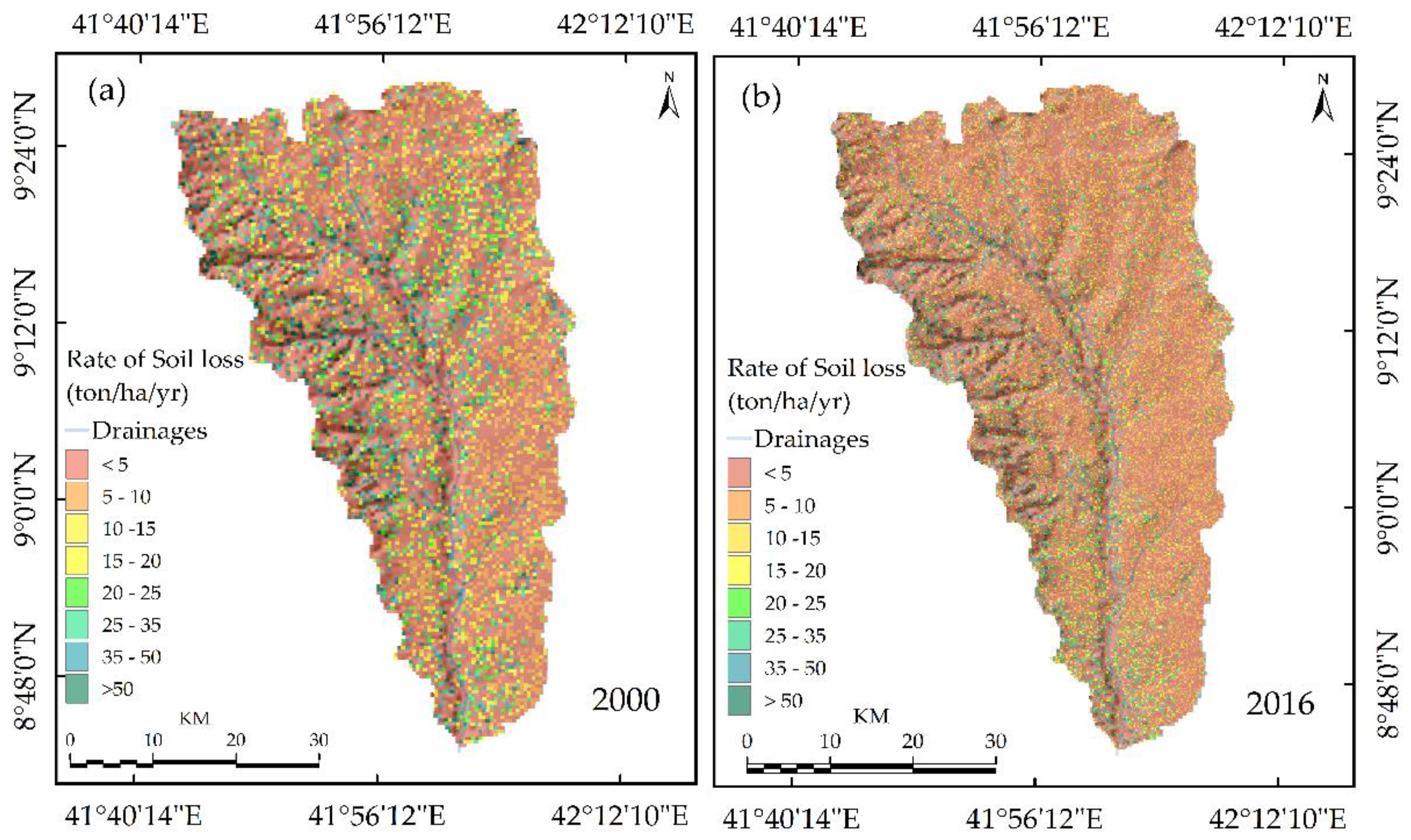

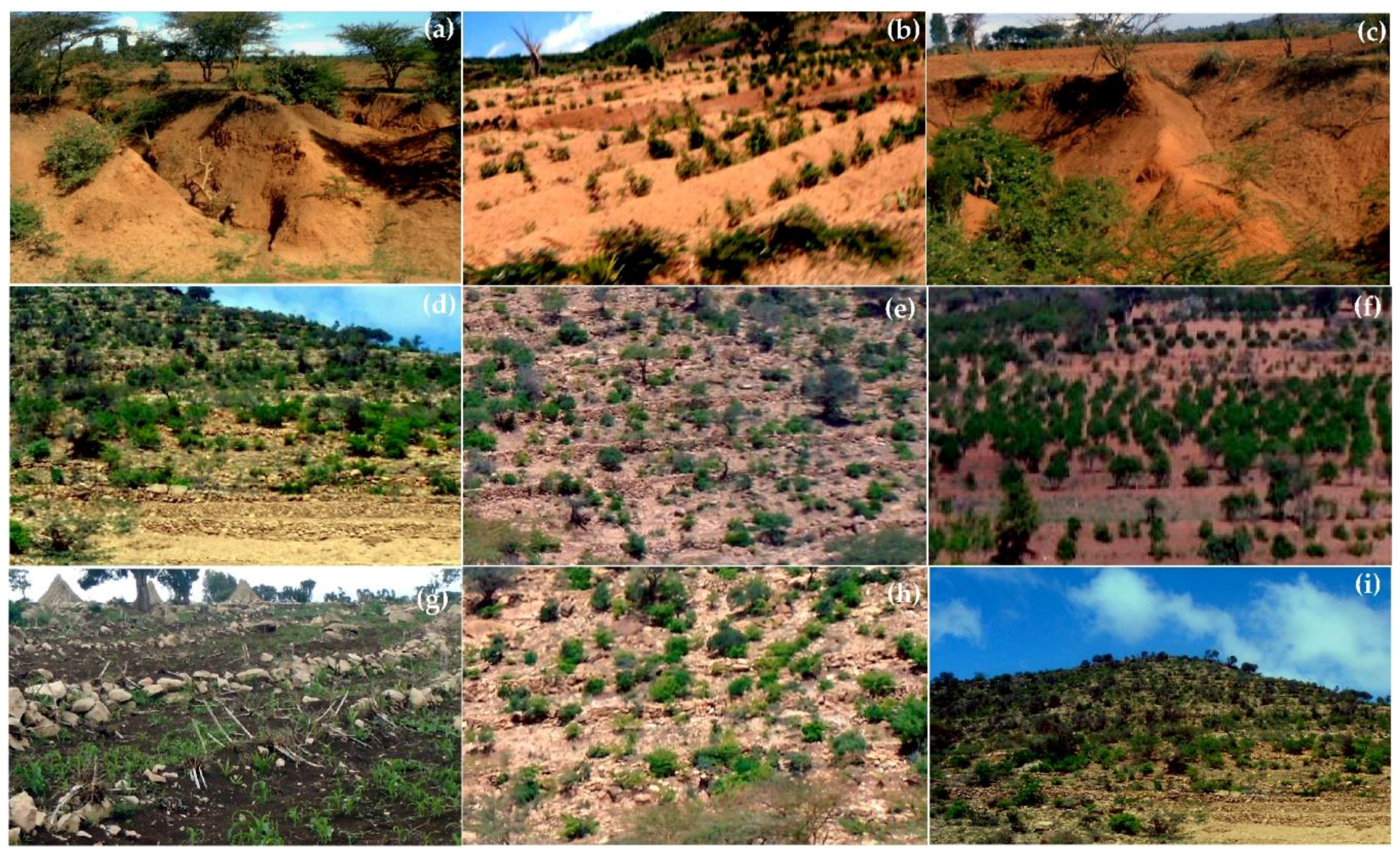
| LULC Class | 2000 | 2016 | Rate of Changes 2000–2016 (%) | ||
|---|---|---|---|---|---|
| ha | % | ha | % | ||
| Bare land | 67,021.03 | 28.19 | 49,932.80 | 21.00 | −25.50 |
| Cultivated land | 64,159.60 | 26.98 | 135,972.81 | 57.18 | 111.93 |
| Forest | 7728.48 | 3.25 | 4794.84 | 2.02 | −37.96 |
| Grazing land | 299.16 | 0.13 | 1863.97 | 0.78 | 523.07 |
| Settlements | 1199.16 | 0.50 | 13,320.50 | 5.60 | 1010.82 |
| Shrub | 96,822.90 | 40.72 | 31,704.40 | 13.33 | −67.26 |
| Water bodies | 556.11 | 0.23 | 197.12 | 0.08 | −64.55 |
| LULC Class | 2000 | 2016 | ||||||
|---|---|---|---|---|---|---|---|---|
| Producers Accuracy % | Users Accuracy % | Kappa (K^) | Producers Accuracy % | Users Accuracy % | Kappa K^ | |||
| Bare land | 69.57 | 86.96 | 0.84 | 95.65 | 100.00 | 1.00 | ||
| Cultivated land | 100.00 | 94.12 | 0.93 | 100.00 | 95.24 | 0.94 | ||
| Settlements | 100.00 | 66.67 | 0.63 | 91.67 | 100.00 | 1.00 | ||
| Forest | 70.00 | 58.33 | 1.00 | 100.00 | 100.00 | 1.00 | ||
| Grazing land | 70.00 | 81.82 | 0.54 | 60.00 | 100.00 | 1.00 | ||
| Shrub | 60.00 | 81.82 | 0.79 | 100.00 | 75.00 | 0.71 | ||
| Water bodies | 93.75 | 100.00 | 1.00 | 100.00 | 100.00 | 1.00 | ||
| 2000 | 2016 | |||||||
| Overall Accuracy (%) | 84.26 | 94.44 | ||||||
| Overall Kappa Statistics | 0.815 | 0.934 | ||||||
| Erosion Risk Class | Rate of Erosion (t ha−1 y−1) |
|---|---|
| Very low | <5 |
| Low | 5–10 |
| Low medium | 10–15 |
| Medium | 15–20 |
| High medium | 20–25 |
| High | 25–35 |
| Very high | 35–50 |
| Extremely high | >50 |
| Soil Loss (t ha−1 y−1) | Erosion Risk Class | 2000 | 2016 | ||
|---|---|---|---|---|---|
| ha | % | ha | % | ||
| <5 | Very low | 184,321.00 | 77.515 | 206,910.00 | 87.015 |
| 5–10 | Low | 32,663.20 | 13.736 | 18,929.50 | 7.961 |
| 10–15 | Low medium | 12,935.50 | 5.440 | 6685.71 | 2.812 |
| 15–20 | Medium | 4176.67 | 1.756 | 2986.66 | 1.256 |
| 20–25 | High medium | 1986.96 | 0.836 | 1295.24 | 0.545 |
| 25–35 | High | 952.93 | 0.401 | 607.86 | 0.256 |
| 35–50 | Very high | 608.25 | 0.256 | 244.76 | 0.103 |
| >50 | Extremely high | 141.93 | 0.060 | 126.67 | 0.053 |
| Soil Erosion Risk Class | A | B | C | D | E | F | G | H | Total 2000 | Loss |
|---|---|---|---|---|---|---|---|---|---|---|
| A | 68.69 | 5.50 | 1.94 | 0.79 | 0.36 | 0.13 | 0.03 | 0.01 | 77.44 | 8.76 |
| B | 11.63 | 1.58 | 0.37 | 0.14 | 0.04 | 0.01 | 0.00 | 0.00 | 13.76 | 12.19 |
| C | 4.38 | 0.58 | 0.34 | 0.09 | 0.04 | 0.01 | 0.01 | 0.00 | 5.44 | 5.11 |
| D | 1.29 | 0.19 | 0.11 | 0.14 | 0.03 | 0.01 | 0.00 | 0.00 | 1.77 | 1.63 |
| E | 0.63 | 0.07 | 0.02 | 0.07 | 0.03 | 0.01 | 0.00 | 0.00 | 0.83 | 0.80 |
| F | 0.28 | 0.03 | 0.02 | 0.02 | 0.03 | 0.01 | 0.01 | 0.00 | 0.41 | 0.40 |
| G | 0.20 | 0.01 | 0.01 | 0.01 | 0.02 | 0.01 | 0.01 | 0.00 | 0.27 | 0.26 |
| H | 0.05 | 0.00 | 0.01 | 0.00 | 0.00 | 0.00 | 0.00 | 0.00 | 0.07 | 0.06 |
| Unchanged | 70.80 | |||||||||
| Total 2016 | 87.15 | 7.96 | 2.82 | 1.26 | 0.55 | 0.19 | 0.06 | 0.01 | ||
| Gain | 18.47 | 6.39 | 2.48 | 1.12 | 0.52 | 0.18 | 0.05 | 0.01 | ||
| Net change | 9.70 | −5.8 | −2.63 | −0.51 | −0.28 | −0.22 | −0.21 | −0.05 |
| Priority Level | Area (ha) | Percentage of Total Area |
|---|---|---|
| 1st priority level | 104.78 | 0.04 |
| 2nd priority level | 1164.27 | 0.49 |
| 3rd priority level | 1963.74 | 0.83 |
| 4th priority level | 306.59 | 0.13 |
| 5th priority level | 5611.78 | 2.36 |
| 6th priority level | 15,186.00 | 6.39 |
| 7th priority level | 6616.90 | 2.78 |
| 8th priority level | 206,832.37 | 86.98 |
© 2018 by the authors. Licensee MDPI, Basel, Switzerland. This article is an open access article distributed under the terms and conditions of the Creative Commons Attribution (CC BY) license (http://creativecommons.org/licenses/by/4.0/).
Share and Cite
Woldemariam, G.W.; Iguala, A.D.; Tekalign, S.; Reddy, R.U. Spatial Modeling of Soil Erosion Risk and Its Implication for Conservation Planning: the Case of the Gobele Watershed, East Hararghe Zone, Ethiopia. Land 2018, 7, 25. https://doi.org/10.3390/land7010025
Woldemariam GW, Iguala AD, Tekalign S, Reddy RU. Spatial Modeling of Soil Erosion Risk and Its Implication for Conservation Planning: the Case of the Gobele Watershed, East Hararghe Zone, Ethiopia. Land. 2018; 7(1):25. https://doi.org/10.3390/land7010025
Chicago/Turabian StyleWoldemariam, Gezahegn Weldu, Anteneh Derribew Iguala, Solomon Tekalign, and Ramireddy Uttama Reddy. 2018. "Spatial Modeling of Soil Erosion Risk and Its Implication for Conservation Planning: the Case of the Gobele Watershed, East Hararghe Zone, Ethiopia" Land 7, no. 1: 25. https://doi.org/10.3390/land7010025






